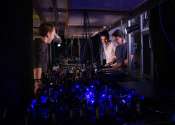New 'retention model' explains enigmatic ribbon at edge of solar system
(Phys.org)—The vast edges of our solar system—the boundary at the edge of our heliosphere where material streaming out from the sun interacts with the galactic material—is essentially invisible. It emits no light and ...








